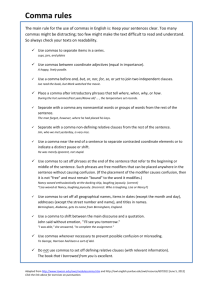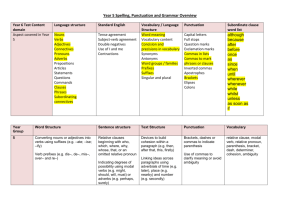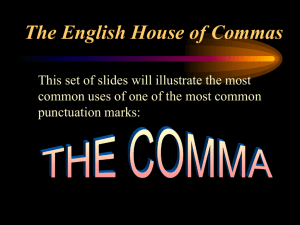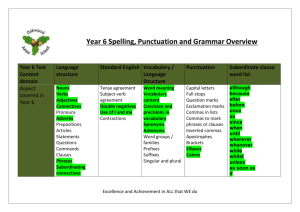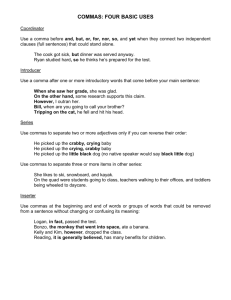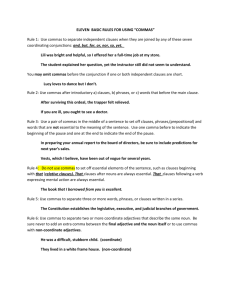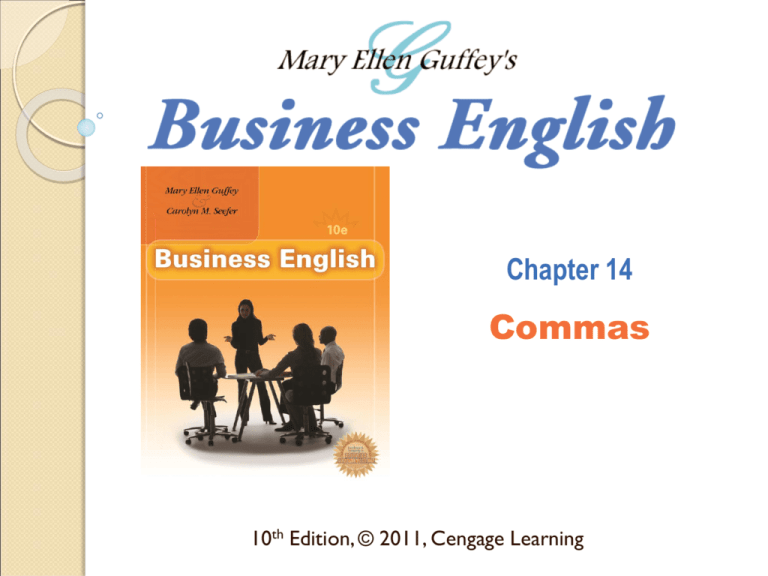
Chapter 14
Commas
10th Edition, © 2011, Cengage Learning
Basic Guidelines for Using
Commas
Series
Direct Address
Parenthetical Expressions
Dates
Time Zones
Addresses and Geographical Items
Appositives
Chapter 11, Guffey-Seefer, Business English, 10e, Copyright 2011 Cengage Learning, All Rights Reserved
11-2
Series
Commas are used to separate three or
more equally ranked (coordinate)
elements (words, phrases, or short
clauses) in a series.
A comma before the conjunction ensures
separation of the last two items.
Chapter 14, Guffey-Seefer, Business English, 10e, Copyright 2011 Cengage Learning, All Rights Reserved
14-3
Series
◦ Series of words: He submitted all production,
distribution, sales, and financial data.
◦ Series of phrases: Government is of the
people, by the people, and for the people.
◦ Series of clauses: Lee investigated hiring, Kelly
studied compensation, and Mark researched
benefits.
No commas are needed when conjunctions
are repeated.
◦ I typed and Mike collated and Lisa stapled.
Chapter 14, Guffey-Seefer, Business English, 10e, Copyright 2011 Cengage Learning, All Rights Reserved
14-4
Direct Address
Words and phrases of direct address are
set off by commas.
◦ We assure you, Ms. Ortiz, that your
bill will be corrected.
◦ Do you know, Dr. Martin, when the
results will be available?
Chapter 14, Guffey-Seefer, Business English, 10e, Copyright 2011 Cengage Learning, All Rights Reserved
14-5
Parenthetical
Expressions
Use commas to set off nonessential words,
phrases, and clauses.
Examples of parentheticals:
as a matter of fact
by the way
for example
in addition
incidentally
in fact
in the meantime
needless to say
no doubt
of course
Chapter 14, Guffey-Seefer, Business English, 10e, Copyright 2011 Cengage Learning, All Rights Reserved
14-6
Parenthetical
Expressions
By the way, have you made your
appointment yet? (At beginning of sentence)
You did, no doubt, make payment with a
credit card. (In middle of sentence)
We’ll need an answer immediately, needless
to say. (End of sentence)
Exception
We have no doubt that your plan will succeed.
Chapter 14, Guffey-Seefer, Business English, 10e, Copyright 2011 Cengage Learning, All Rights Reserved
14-7
Dates
When dates contain more than one element, the
second and following elements are normally set off
by commas.
◦ A sales record was set November 14 in Chicago. (No
comma needed for one element.)
◦ A sales record was set Wednesday, November 14, in
Chicago. (Two commas set off second element.)
◦ A sales record was set Wednesday, November 14, 2012, in
Chicago. (Commas set off second and third elements.)
In April 2011 we opened a second office. (Exception:
The comma is omitted in writing month and year
only.)
Chapter 14, Guffey-Seefer, Business English, 10e, Copyright 2011 Cengage Learning, All Rights Reserved
14-8
Time
Zones
Commas set off time zones used with
clock times.
◦ His flight left at 11:10 a.m., EST, and
arrived in Los Angeles at 1:50 p.m., PST.
Chapter 14, Guffey-Seefer, Business English, 10e, Copyright 2011 Cengage Learning, All Rights Reserved
14-9
Addresses
and Geographical Items
When addresses and geographical items contain
more than one element, the second and
following elements should be set off by commas.
◦ The letter from Jane Mangrum, Miami-Dade
Community College, Miami, Florida 33176, was
provocative.
◦ We received inquiries from San Antonio, Texas, and
Tampa, Florida.
◦ Last summer we traveled to Paris, France, and
London, England, for our honeymoon.
Chapter 14, Guffey-Seefer, Business English, 10e, Copyright 2011 Cengage Learning, All Rights Reserved
14-10
Appositives
An appositive that provides information not
essential to the identification of its antecedent
should be set off by commas.
◦ Douglas Dawson, the wireless customer
service rep, called. (The appositive adds
nonessential information; commas set it off.)
◦ The wireless customer service rep Douglas
Dawson called. (The appositive is needed to
identify which sales representative called; therefore,
no commas are used.)
◦ My brother Keith will visit in December. (One-word
appositives do not require commas.)
Chapter 14, Guffey-Seefer, Business English, 10e, Copyright 2011 Cengage Learning, All Rights Reserved
14-11
Special Guidelines for Using
Commas
Independent Adjectives
Introductory Verbal Phrases
Prepositional Phrases
Independent Clauses
Introductory Clauses
Terminal Dependent Clauses
Nonessential Clauses
Chapter 11, Guffey-Seefer, Business English, 10e, Copyright 2011 Cengage Learning, All Rights Reserved
11-12
Independent Adjectives
Two adjectives that equally modify a noun
should be separated by a comma.
◦ How many laborious, inefficient
procedures can we eliminate?
Chapter 14, Guffey-Seefer, Business English, 10e, Copyright 2011 Cengage Learning, All Rights Reserved
14-13
Introductory Verbal
Phrases
Verbal phrases that precede main clauses
should be followed by commas.
◦ Hoping to get a seat, James
arrived early.
◦ To complete the job, we must
work overtime.
◦ Shocked, we listened to the CEO’s
announcement.
Chapter 14, Guffey-Seefer, Business English, 10e, Copyright 2011 Cengage Learning, All Rights Reserved
14-14
Prepositional
Phrases
One or more introductory prepositional
phrases totaling four or more words should be
followed by a comma.
◦ For the past six months, e-mail
service has been erratic.
◦ In the spring of next year, we will try
a new system.
Introductory prepositional phrases of three or
fewer words require no commas.
Chapter 14, Guffey-Seefer, Business English, 10e, Copyright 2011 Cengage Learning, All Rights Reserved
14-15
Prepositional
Phrases
Examples:
◦ By next Monday you will receive your order.
◦ In 2013 the new tax will be repealed.
◦ In this case we will not intervene.
◦ On Friday I will place an order on your Web
site.
Do
NOT use commas to set off internal
prepositional phrases that do not
interrupt the sentence.
◦ We do not at this time anticipate layoffs.
Chapter 14, Guffey-Seefer, Business English, 10e, Copyright 2011 Cengage Learning, All Rights Reserved
14-16
Independent
Clauses
When a coordinating conjunction joins
independent clauses, use a comma before the
conjunction—unless the clauses are short (up
to 13 words).
◦ The computer is an efficient tool of
management, but it does not eliminate the
need for managers.
◦ We have tried many times and we have failed.
(No comma)
Chapter 14, Guffey-Seefer, Business English, 10e, Copyright 2011 Cengage Learning, All Rights Reserved
14-17
Introductory
Clauses
Dependent clauses that precede
independent clauses are followed by
commas. [NOTE:This is probably the most
frequently missed comma in business writing.]
◦ When Mark was hired, his manager
outlined his duties.
◦ If Jennifer applies, we will surely hire
her.
Chapter 14, Guffey-Seefer, Business English, 10e, Copyright 2011 Cengage Learning, All Rights Reserved
14-18
Terminal
Dependent Clauses
Use a comma before a dependent clause at the
end of a sentence ONLY if the clause adds
nonessential information.
Information is considered essential if it answers
questions such as When? Why? and How?
We are usually open from 10 until 5,
although we can make special
arrangements if necessary. (Although
clause ads extra nonessential information.)
His duties were outlined when he was
hired. (When clause adds essential information.)
Chapter 14, Guffey-Seefer, Business English, 10e, Copyright 2011 Cengage Learning, All Rights Reserved
14-19
Nonessential
Clauses
Use commas to set off clauses that are
used parenthetically or that supply
information unneeded for the grammatical
completeness of a sentence.
Melanie Lipman, who teaches in
California, submitted excellent
suggestions.
Chapter 14, Guffey-Seefer, Business English, 10e, Copyright 2011 Cengage Learning, All Rights Reserved
14-20
Additional Guidelines for Using
Commas
Degrees and Abbreviations
Numerals
Omitted Words
Contrasting Statements
Clarity
Short Quotations
Chapter 11, Guffey-Seefer, Business English, 10e, Copyright 2011 Cengage Learning, All Rights Reserved
11-21
Degrees
and Abbreviations
Except for Jr., Sr., and Roman numerals, degrees,
personal titles, and professional designations
following individuals’ names are set off by
commas.
◦ Fritz Werner Jr. and Fritz Werner Sr. attended
Stafford Elahi III’s graduation.
◦ Paul William Murphey, PhD, is the keynote
speaker.
◦ Expert witness Todd James, MD, supported the
defense.
Chapter 14, Guffey-Seefer, Business English, 10e, Copyright 2011 Cengage Learning, All Rights Reserved 14-22
Degrees
and Abbreviations
The abbreviations Inc. and Ltd. are set
off by commas if the company’s legal name
includes the commas.
◦ Scandia, Inc., advertised this dining set.
◦ Lamps Ltd. is now located in the mall.
(Legal name does not include comma
before Ltd.)
Chapter 14, Guffey-Seefer, Business English, 10e, Copyright 2011 Cengage Learning, All Rights Reserved
14-23
Numerals
Unrelated figures appearing side by side should
be separated by commas .
◦ By 2014, 54 franchises will be in operation.
Numerals of more than three digits require
commas.
4,321
43,210
4,321,000
Calendar years, zip codes, and telephone, house,
decimal, page, serial, contract, account, and
identification numbers do not require commas.
Chapter 14, Guffey-Seefer, Business English, 10e, Copyright 2011 Cengage Learning, All Rights Reserved
14-24
Omitted Words
A comma is used to show the omission of
understood words.
◦ Some employees leave work at 5 p.m.;
others, at 5:30 p.m.
Chapter 14, Guffey-Seefer, Business English, 10e, Copyright 2011 Cengage Learning, All Rights Reserved
14-25
Contrasting
Statements
Commas are used to set off contrasting
or opposing expressions.
◦ Managers are made, not born.
◦ The greater the sales, the greater the
profits.
Chapter 14, Guffey-Seefer, Business English, 10e, Copyright 2011 Cengage Learning, All Rights Reserved
14-26
Clarity
Commas are used to separate words
repeated for emphasis and words that
may be misread if not separated.
◦ We had a long, long meeting to iron
out differences.
◦ In short, employees must be more
courteous.
◦ What it is, is hard work.
Chapter 14, Guffey-Seefer, Business English, 10e, Copyright 2011 Cengage Learning, All Rights Reserved
14-27
Degrees
and Abbreviations
A comma is used to separate a short
quotation from the rest of the sentence. If
the quotation is divided into two parts,
two commas are necessary.
◦ Mark Twain said, “We all have our
limitations in the matter of grammar.”
◦ “I have never seen a book,” he added,
“which had no grammatical defects in
it.”
Chapter 14, Guffey-Seefer, Business English, 10e, Copyright 2011 Cengage Learning, All Rights Reserved
14-28



